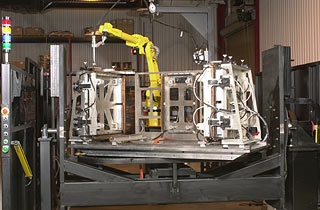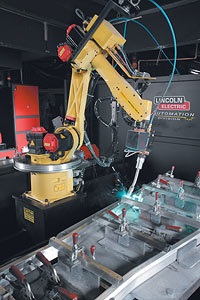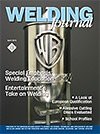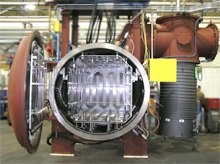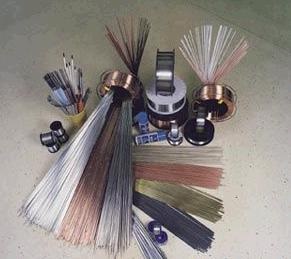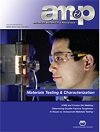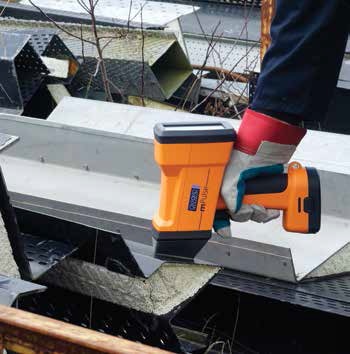| Back to Back Issues Page | |||||||||||||
 |
|||||||||||||
|
PWL#129 - Jigs and Fixtures Basic Design, Vacuum Furnace Brazing, Filler Catalogs,Mobile Welding Svc May 01, 2014 |
|||||||||||||
| We hope you will find this Letter interesting and useful. Let us know what you think of it.
PWL#129 Welding Jigs and Fixtures Basic Design Requirements, Vacuum Furnace Brazing with Getter, Filler Metals Manufacturers Catalogs, Mobile Welding Customer Service, New Handheld Material Analyzer, Welding Molybdenum (R), Welding Cobalt (R), Bulletin_95 and much more...
May 2014 - Practical Welding Letter - Issue No.129
DON'T USE REPLY to send your messages! Use the Contact Us form instead. This publication
brings to the readers practical answers to welding problems in an informal setting designed to be helpful and informative. We actively seek feedback to make it ever more useful and up to date. We encourage you to comment and to contribute your experience, if you think it may be useful to your fellow readers. You are urged to pass-along this publication to your friends, if you like it, and if you think it may help them. If you received this from a friend and if you like what you read, please subscribe free of charge and you will also receive a bonus book on Practical HARDNESS TESTING Made Simple. The addresses reported hereafter were live and correct at the time of their publication. There is no guarantee that they will always be so, because they are administered by the sources themselves and are under their control. Note: References to articles or other documents are given here in If they are URL's (Uniform Resource Locator), which is the analogue of an address, they begin with "http://..." or "www.". These are not live and must be copied and pasted entirely into the browser (after having been selected with the mouse or otherwise). If they are long they may be displayed in two or more lines. In that case one has to care that the URL be copied completely in a single line without any space, and Enter. If the information is important to you as we hope, you may save the selected pages in a suitable folder on your Computer for easy reference. You are welcome to forward this page to those of your friends who may profit of this information.
(Sponsored Links)
1 - Introduction 2 - Article - Welding Jigs and Fixtures 3 - How to do it well: Vacuum Furnace Brazing 4 - Filler Metal Catalogs 5 - Online Press: recent Welding related Articles 6 - Terms and Definitions Reminder 7 - Article: Mobile Welding Service 8 - Site Updating: Welding Molybdenum (R), Welding Cobalt (R), Bulletin_95 9 - Short Items 10 - Explorations: beyond the Welder 11 - Contributions: A new Handheld Material Analyzer 12 - Testimonials 13 - Correspondence: a few Comments 14 - Bulletin Board
2 - Article - Welding Jigs and Fixtures
From Fixturing for Robotic Welding
In any weldment, a number of elements or subassemblies must be presented to the welding operation in well defined positions, relative directions and specific tolerances, in order that the final product be manufactured with the required quality at minimum cost. For prototype work or for individual parts, generic holding tables are used, with universal accessories like clamps, magnets or framing squares. The temporary assembly permits to perform tack welding, allowing the weldment to be removed as a unity, if necessary, for completing all required welding. Complexity of parts reflects in that of the fixtures needed for making them. Standard clamping devices are available in the market, that can be easily mounted on simple platforms and then removed for further use in other devices. For repetitive work it is found that properly designed and built jigs or fixtures are essential for assuring production quality and for limiting costs. Fixtures free the assemblers from the need of measuring or of taking decisions regarding components relative positions, as these just fall in the prepared places. Their make up avoids erroneous identification and positioning of parts (fool proof) and helps in identifying out of tolerance components. Tighter tolerances become achievable, and distortion can be minimized if specific welding sequences are prescribed. In summary, the use of suitable fixtures saves assembling time, avoids costly errors, improves quality and weld consistency at minimum costs. Several design requirements are singled out as favorable features that should be present in every good fixture. Among these simplicity, inexpensiveness, rigidity exceeding that of the welded product. Clamping devices should be protected from spatter that may accumulate on critical surfaces. Joints should be welded preferably in flat position, and fixtures should allow that, whenever possible. Thermal expansion while welding should be accounted for, with freedom of movement when required. Electrical conductivity must be assured for correct grounding and unhindered weld current flow. For unique realizations of complex weldments, modular tooling that provides interchangeable set-ups is available. Three categories are known to which almost all fixtures are normally ascribed. Tacking Fixtures are those used only to tack weld assemblies, after the elements are mounted in their correct position and orientation. Tack welded assemblies are then removed and welded elsewhere. These are generally simpler and lighter fixtures that do not need to withstand expansion stresses developed during massive welding. Welding fixtures are more sturdy than those described above as they must bear the thermal stresses developed while welding progresses. In this category are fixtures, designed for quick load and discharge, presenting parts to robotic welding. Robots must find unobstructed access to weld seams, and reliable ways to orient themselves positively relative to fixture reference points. To this category belong also those seamers which keep the edges of sheet metal formed parts aligned, with sets of clamping fingers against suitable backup bars, for performing high quality butt welds. Holding fixtures are those to be mounted on positioners with their assemblies already tack welded, and ready to be submitted to the correct welding sequence. Using positioners it is easier to bring always the weld seam to the welding torch in flat position, for highest speed and best quality. Readers with direct experience of design of complex welding fixtures are invited to show and explain to our readership some of their best achievements for our enlightenment. Use the Contact Us form.
From Fixturing for Robotic Welding
3 - How to do it well: Vacuum Furnace Brazing
It is well known that vacuum is a suitable environment for brazing materials. Vacuum helps keep metal surfaces bright and clean at the brazing temperatures, provided the vacuum level is sufficient. The main reason for using vacuum brazing is that, if suitable conditions are present, it allows the process without the use of fluxes, aggressive agents that attack metals and reduce oxides. This advantage eliminates the need of removing flux traces after brazing (to avoid further corrosion), which may be a difficult task especially from tight and complex joints. Commercial brazing furnaces operate at pressures from 10-6 torr (1 torr = 1 mm Hg = 133 Pa) to 0.5 torr. The influencing factors that determine success or failure of the brazing operation are the surface condition of base and filler materials being brazed, the areas of the brazed interfaces and type and amount of gases and other contaminants being liberated in the process. Furthermore certain oxides present in the metals may dissociate at the prevailing conditions of temperature and pressure, providing oxygen that deteriorates the quality of the protective atmosphere. This quality depends also on equipment condition, pumps performance and general leaking in the joints. It is known that an effective method to improve it consists in providing a getter. A getter is a material like titanium, having a great capacity to adsorb oxygen, especially if in a finely divided form of large surface to mass, the so called aspect ratio, like powder or clean turnings. To find at which temperature and vacuum level specific metal oxides are being reduced, one uses diagrams of equilibrium, whose curves indicate, at their right side, the reduction conditions. On the contrary, on the curve itself and in the space at its left, the conditions promote oxidation. Titanium, being readily oxidized, removes oxygen traces from the atmosphere, present say from the dissociation of chromium oxide (Cr2O3). Once oxygen and contaminants have been sequestered by titanium, there is no chance that they will be liberated again, because such conditions (positioned to the right of the TiO curve) are never reached in normal brazing cycles. Examples of such diagrams can be downloaded from It is important to remember that titanium getter material must be prevented from contacting stainless steel or nickel alloys, because of a low melting eutectic alloy reaction forming at about 955 °C. Titanium getter material should be used during maintenance clean-up cycles, besides actual brazing processing. Spent, used getter material becomes brittle upon furnace exposure and should be discarded. An article discussing the subjects mentioned above was published in the April 2014 issue of the Welding Journal at page 22. Interested readers are invited to seek it, for achieving a deeper understanding of the matter. Visitors may also wish to see our page on Brazing Heating. Several articles on Brazing were published along many years in different issues of Practical Welding Letter. They can be retrieved by performing a search in any of the boxes appearing in almost all pages of www.welding-advisers.com See also our Bulletin 95 which presents a list of Online Resources on Vacuum Brazing, including instructive brochures from commercial enterprises.
Vacuum Aluminum Brazing Furnace
4 - Filler Metal Catalogs When looking for solutions to specific problems, readers are generally doubtful that the information available from commercial companies might be biased to serve their own interests. However it is sufficient to remain alert and consider critically any recommendation, to be able to profit from the wealth of information the companies developed for their business. Also comparing information from independent sources may help obtaining useful knowledge. Readers who occasionally look for details on filler metals, might consider bookmarking this note, which gives access to selected catalogs likely to be of help when searching for definite solutions. Hobart Filler Metal Selector Welding Filler Metals (288 pages) American Filler Metals Catalog (262 pages) Filler Metals for Repair, Hardfacing and Cladding Applications (516 pages) Products and Solutions Comments and feedback are welcome.
Consumables, from
5 - Online Press: recent Welding related Articles Smartphones: Convenient Way to Get a Perfect Weld Lincoln Electric Launches Weld Parameter Mobile App ROFIN to Highlight Laser Welding Equipment for Tubes and Profiles at TUBE 2014 Primoceler to build laser-welded optical sensor packages for future ESA orbital missions Elektron introduces TrueAutoMode for fully automatic spot welding Fusion Line Issue 37 Spring 2014 - Download Newsletter from
6 - Terms and Definitions Reminder Welding test position designation is a symbolic representation for a fillet weld or a groove weld, the joint orientation and the welding test position. A few designations are listed hereafter. 1F - pipe is a Welding test position designation for a circumferential fillet weld applied to a joint in pipe with its axis approximately 45° from horizontal, in which the weld is made in flat welding position by rotating the pipe about its axis. 1F - plate is a Welding test position designation for a linear fillet weld applied to a joint in which the weld is made in flat welding position. (The two plates lie at 45° from the horizontal plane). 2F - pipe is a Welding test position designation for a circumferential fillet weld applied to a joint in pipe with its axis approximately vertical, in which the weld is made in horizontal position. 2F - plate is a Welding test position designation for a linear fillet weld applied to a joint in which the weld is made in the horizontal welding position. (One of the plates is horizontal, the other vertical). 2FR is a Welding test position designation for a circumferential fillet weld applied to a joint in pipe its axis approximately horizontal, in which the weld is made in horizontal welding position by rotating the pipe about its axis. 4F - plate is a Welding test position designation for a linear fillet weld applied to a joint in which the weld is made in overhead welding position. 4F - pipe is a Welding test position designation for a circumferential fillet weld applied to a joint in pipe with its axis approximately vertical, in which the weld is made in overhead position. 5F is a Welding test position designation for a circumferential fillet weld applied to a joint in pipe with its axis is approximately horizontal, in which the pipe remains fixed and the weld is made in the horizontal, vertical and overhead welding positions. 6F is is a Welding test position designation for a circumferential fillet weld applied to a joint in pipe with its axis approximately 45° from horizontal, in which the pipe remains fixed and the weld is made in the horizontal, vertical and overhead welding positions. Note: Illustrations for the above pipe welding positions can be found in Datasheet 313 published in the Welding Journal of March 2010 at page 70.
7 - Article: Mobile Welding Service
We Come to You
I ran into this kind of job shop as I received a letter from a welder, with 35 years of experience, who set up such a business and was asking for hints on how to improve his own exposure to a larger customer base. From a brief review of websites promoting such activities for their owners, I can see that one of the most efficient means to reach more people looking for this service is the publication of testimonials written by satisfied customers. Knowledgeable welders with pride and self esteem for their professional achievements may wrongly think that it is superfluous to dedicate a sincere interest for the basic needs of the people they work for. That would be a mistake. On the contrary, if customers can feel sincere sympathy for their personal problems, from the part of extraneous workers they called to help them, they will gladly testify on their satisfaction for their positive experience and recommend heartily to their best friends those service providers. Favorable word of mouth is likely the best advertisement. On the professional side, if asked for an opinion, I would say that the largest risk might be overconfidence of the welder in his understanding of the case. I would suggest, in case of doubt, to look in more depth for the kind of material on hand, even if delivery may be delayed somewhat. I am sure that the customer will appreciate the caution, meaning love for serious work, preferred to immediate doing of doubtful making. One of the best instruments to be used for identifying the type of material, is a hand held XRF detector, which can be probably obtained on lease from many sources. See our page on Material Identification. See also a new device, in Section 11 further down this page. Welding service providers should develop an instinct for dangerous undertakings they should keep clear of, unless covered in detail by engineering instructions relieving the worker from taking responsibilities he/she cannot assume. In particular lifting devices as well as pressure containing vessels may be subject to control by official authority and need coverage of special procedures before being approved. Ignorance of requirements is not an excuse. I would like to remind the general warning of my page on Welding Liability, recommending extreme caution, especially with devices that could cause harm upon failing. Readers with first hand experience in mobile welding service are warmly invited to let us know and inform our readers of useful teachings, by using the
8 - Site Updating: Welding Molybdenum (R), Welding Cobalt (R), Bulletin_95 The edited and revised Pages of this Month refer to two somewhat special metals. The elements of the same name are found in many alloys but, for special purposes, alloys are available where these are the main constituents. As special precautions are needed for best welding results, it is appropriate to dedicate a special page to each one, and also resource pages, with online links to main knowledge source. That for Molybdenum, still missing, will be prepared as soon as possible. The first page deal with Welding Molybdenum, used sometimes for heating elements of vacuum furnaces. The other page covers Welding Cobalt and its alloys, many of which are used as heat resisting materials at elevated temperatures. A new page listing Resources on Vacuum Brazing was recently published. It is found at Bulletin 95. Readers know that the Site Map is a good place wherefrom to start when in search of a welding subject. Another way is to perform a search from the boxes appearing in almost all pages of our website Questions, comments and feedback are always welcome. 9 - Short Items
9.1 - Oil Quenching is the rapid cooling of steel, heated above the austenitic transformation temperature, in order to get hardened microstructures like martensite and by avoiding less hard transformation phases like bainite. Quenching is usually performed by immersion of the red hot steel in an oil bath, with agitation to accelerate heat removal. 9.2 - Plane Strain is the stress condition in linear elastic fracture mechanics in which there is zero strain in a direction normal to both the axis of applied tensile stress and the direction of crack growth (that is, parallel to the crack front). Most nearly achieved in loading thick plates along a direction parallel to the plate surface. Under plane-strain conditions, the plane of fracture instability is normal to the axis of the principal tensile stress. 9.3 - Restriking consists in the striking again of a trimmed but slightly misaligned or otherwise faulty forging with one or more blows to improve alignment, improve surface condition, maintain close tolerances, increase hardness, or effect other improvements. Also a sizing operation in which coining or stretching is used to correct or alter profiles and to counteract distortion. And a salvage operation following a primary forging operation in which the parts involved are re hit in the same forging die in which the pieces were last forged. 9.4 - Sandblasting is a type of Abrasive blasting with sand or with other material to remove scale, corrosion, paint or surface conditions that need to be eliminated for further processing. 9.5 - Tin Pest is a polymorphic modification of tin that causes it to crumble into a powder known as gray tin. It is generally accepted that the maximum rate of transformation occurs at about -40 °C (-40 °F), but transformation can occur at as high as about 13 °C (55 °F). 9.6 - Widmanstätten Structure is characterized by a geometrical pattern resulting from the formation of a new phase along certain crystallographic planes of the parent solid solution. The orientation of the lattice in the new phase is related crystallographically to the orientation of the lattice in the parent phase. The structure was originally observed in meteorites, but is readily produced in many alloys, such as titanium, by appropriate heat treatment.
10 - Explorations: beyond the Welder
Washington State Euthanizes 300 birds after Cockfighting Farm Raided Nepal Government Meets Sherpas' Demands after Deadly Avalanche First Earth-Size Planet That Could Support Life Found Outrage Against the Machines Introduction to Traditional Peer Review
11 - Contributions: A new Handheld Material Analyzer
Readers may remember that one of my strongest recommendations for Material Identification, is the use of a non destructive method called XRF (X-Ray Fluorescence). Instruments providing analysis based on that method may be found not only in laboratories but also with metal suppliers, foundries and even junk-yards. Their large diffusion is due to their usefulness, as they provide, non destructively, instant identification of many materials. At the very least they point to the most important elements present in the sample examined. A new hand held laser based instrument doing a similar analysis was announced in Advanced Materials and Processes (AM&P), a publication of ASM International, in the April issue, at page 24. Laser-Induced Breakdown Spectroscopy (LIBS) is an atomic emission technique where a common laser fires pulses on the target. Ablated atoms of the material constituents are ionized by the laser light and their electrons become excited. Upon relaxation, photons are emitted, characteristic of the elements and their electron transitions. The spectrum of such light is dispersed and analyzed by a suitable spectrometer operating in a defined wavelength range, typically between 170 and 1100 nanometers. The article points out that instruments using this same principle were available in laboratories from the sixties of last century. Only recent advancements in microelectronics and in nano technology permitted to pack all the needed hardware in a hand held device, to provide the much sought portability for field use. Compared to XRF the new instrument has the advantages of not needing ionizing radiation, and of being able to analyze also certain light elements not available with the previous technique. The usual precautions to be used to prevent laser light from harming eyes of bystanders make the technique safe for use. Additional development involving a learning curve of both manufacturers and users will be needed to advance the capabilities of the instrument to satisfy special needs. As core LIBS components become smaller and more capable, it is probably only a question of time until the new hand held instrument will provide the performance and the advantages of their laboratory counterparts. Interested readers are urged to seek the original article pointed at above.
mPulse - LIBS Handheld Analyzer
12 - Testimonials On Mon Mar 24 12:20:54 2014, the following results were submitted from the "Form 5" on welding-advisers.com: Name: John Hunter
Date: 10 Apr 2014, 11:13:38 AM Name: Derek Foulkes
13 - Correspondence: a few Comments I believe that it is quite common and acceptable not to answer to unsolicited mail. However, in my opinion, it is uncivil behavior not to thank after receiving an answer following a query, even if not exactly satisfactory. However this is what happens most of times, unfortunately.
14 - Bulletin Board 14.1 - AWS Weldmex, FABTECH® Mexico, METALFORM Mexico. 14.2 - The International Conference on Shape Memory and Superelastic Technologies (SMST™) 14.3 - The 17th Aluminum Welding Conference 14.4 - 5th International Conference on
Watch the Video: and also:

BUILT BY: Click on this Logo NOW! 
Copyright (©) 2014, by Elia E. Levi and
See you next time...
|
|||||||||||||
| Back to Back Issues Page |
